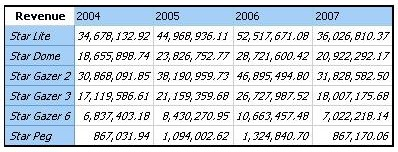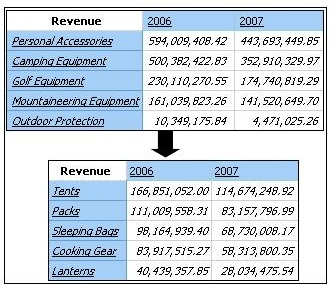IBM Cognos 10 BI Multidimensional Author v6.0
Question 1
If the syntax for thehead function is head(set_exp[,index_exp]),then which of the following expressions is correct?
- A. head(members([sales_and_marketing].[Products].[Products].[Product line]),2)
- B. head(([sales_and_marketing].[Products].[Products].[Product line])[,2])
- C. head(order([sales_and_marketing].[Products].[Products].[Product line])2)
- D. head(members([sales_and_marketing].[Products].[Products].[Product line],2))
Answer : A
Question 2
Which of the following family functions is most similar to the relativetime function parallelPeriod?
- A. Cousin
- B. PrevMember
- C. Siblings
- D. OpeningPeriod
Answer : A
Question 3
What does the following expression do:
"generate([Productline],topCount(descendants(currentMember([sales_and_marketing].[Pro ducts].[Products]),[sales_and_marketing].[Products].[Products].[Product]),2,[Revenue]))"?
- A. Returns the top two products by revenue for each product line.
- B. Finds the top two members by revenue at the product level and returns their respective ancestors at the product line level.
- C. Calculates the top two product lines for each product.
- D. Goes two levels up from products and returns the top members by revenue at that level.
Answer : A
Question 4
What is a key difference between the total function and the aggregate function?
- A. The aggregate function can only summarize within a set, and the total function can accept separate members.
- B. The aggregate function isdimensional, and the total function is relational.
- C. The aggregate function will summarize only the currentMeasure, and the total function will summarize any specified measure.
- D. The aggregate function follows the rollup rules of the measure defined in the data source, and the total function adds the total of the specified measure.
Answer : D
Question 5
The dialog box shown appears when a report is run.
What should the report author do to correct the situation?
- A. Ask the modeler to rename the hierarchy to '[sales_and_marketing].[Products].[Products].[Products]', and to republish the package.
- B. Modify the expression to change the 'currentMember' function to 'currentLevel'.
- C. Modify the expression to change the 'currentMember' function to 'currentHierarchy'.
- D. Modify the expression to 'currentMember([sales_and_marketing].[Products].[Products])'.
Answer : D
Question 6
Based on the crosstab displayed, the report author creates a singleton using the tuple function as follows: tuple([Camping Equipment],[Revenue],[2006]).
Which of the following will appear in the singleton when the report is run?
- A. Camping Equipment, 500,382,422.83, 2006
- B. 500,382,422.83
- C. Camping Equipment, Revenue, 2006
- D. Nothing, singletons are notdimensional objects.
Answer : B
Question 7
In a crosstab report, the report author wants a column to display a percentage of overall revenue that a particular product contributed to.

Which of the following is a valid dimensional expression forthis purpose?
- A. tuple([Revenue]/[Products]*[Revenue])
- B. [Revenue]/([Revenue]*[Products])
- C. [Revenue]/tuple([Revenue],[Products])
- D. [Revenue]/total([Revenue]for[Products])
Answer : C
Question 8
A report author creates an expression usingthe closingPeriod function to return the latest month found in the data source, and names the expression "Current Month". What can the report author do with "Current Month"?
- A. Use it to replace the lastPeriods(1,[Month]) expression currently in the report.
- B. Add it to an expression to find the current member for the Month level.
- C. Use it to determine the current quarter: parent([Current Month]).
- D. Use it as a report expression to display the current month in the page header of the report.
Answer : C
Question 9
Can a prompt be used in the expression of a slicer?
- A. Yes, if the correct syntax is used.
- B. No, the slicer syntax is not compatible with prompt syntax.
- C. Yes, if the slicer is a hierarchy.
- D. No, the slicer must be manually created by the report author.
Answer : A
Question 10
Of the following prompt syntax expressions, which two are considered to be dimensional?
1) <expression> -> ?<prompt name>?
2) <expression> in (?<prompt name>?)
3) <expression> = ?<prompt name>?
4) set(<expression> -> ?<prompt name>?)
- A. 1 and 4
- B. 1 and 2
- C. 2 and 3
- D. 3 and 4
Answer : A
Question 11
Which of the following statements is correct about the order function?
- A. The currentMeasure function must be used with the orderfunction as the sort by criterion.
- B. It arranges members of all sets in the report by ascending or descending values.
- C. Optional parameters allow the author to order the members of a hierarchy without regard of their level.
- D. It arranges members of a set alphabetically by ascending or descending captions.
Answer : C
Question 12
Instead of prompting the user to select any countries in Europe, the report author wants to constrain the user to select one or more countries from the Northern Europe region. What kind of prompt should be used and how can this be achieved?
- A. This is not possible because a prompt must always be populated with all members of a level.
- B. Create a multi-select value prompt. Populate it using an expression on the [Northern Europe] member to retrieve its children on the country level.
- C. Generate a prompt by creating an expression with a parameter on the crosstab edge: children([Northern Europe]->?Country?
- D. Create a tree prompt, and populate it using an expression on the[Northern Europe] member to retrieve its children at the country level.
Answer : B
Question 13
Based on the diagram,
if the expression firstSibling([2006 Q 1]) is used in the report, what item will be returned?
- A. 2005 Q 1
- B. 2006 Q 4
- C. 2006 Q 1
- D. Nothing, because the return value equals the parameter
Answer : C
Question 14
What is the default behavior when drilling down on an edge in a crosstab report?
- A. The level drilled on is replaced with the entire level below it.
- B. The edge expression is replaced with the children of the item drilled on.
- C. All edge expressions of the crosstab are replaced with their children.
- D. The edge expression is changed to another item in the query.
Answer : B
Question 15
A report authorhas created a crosstab report from the data source shown. The Retailer name level has been dragged to the rows and default drilling up and down has been activated.
What will be displayed in the report if the consumer drills up on one of the members of
Retailer name?
- A. The parent member of the member drilled on.
- B. The ancestors of the member drilled on from the whole Retailers hierarchy.
- C. The members from the Region level.
- D. The members from the Retailer country level.
Answer : D
Explanation:
QUESTIONNO: 46 -
The author has created a complex expression called "Sorted Products" on the row edge, which sorts product line by Revenue for 2006.

C:\Pasban Work\Cert Paper Exams\IBM\IBM-Cognos\COG-645\COG-645-Extracted\COG-
645-Extracted\COG645A\46.JPG
What must the report author do to sort the members when drilling down?
A. Configure the Ancestor drill behavior on the Sorted Products expression.
B. Preserve the Sorted Products expression, but replace the underlying Product Set expression.
C. Nothing, as the default drill behavior is sufficient in this case, to maintain sorting of the children.
D. Set the behavior to Depth Based Expression, to maintain sorting at a lower level in the data source.
Answer: B -